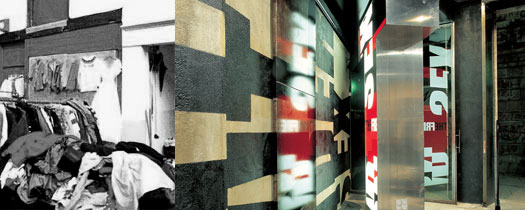
El Born is a part of the city lined with narrow streets and alleyways, the only space where the densely packed old part of town allows people to move freely. A structure with medieval origins stands on a site where knights competed in tournaments, from which the district got its name, and where a covered market was later established by opening up a large square. Selling on the street is done differently – a stall, a street market, illegal street vendors, a stand amidst the to-ing and fro-ing, hawkers which use the ground to show off their wares. We find ourselves in the busiest part of the area where there are unexpected narrow alleyways which the sun can barely reach. We have now moved on from the former market to the assortment of shops facing out to the street.
All these ideas led us to create a new kind of street, a space where people come and go, a hidden alleyway with a street market, a place for commerce. Sales are transacted in this shop which connects two different streets, a passageway signposted in large, bright letters. Theses give it an identity and once in place on the inside they establish a space and create a layout suitable for exchange, for trade.
Minimum intervention was required. The number of arched hollows in the façades increases in the calles de Esparteria and del Bonaire, meaning that even when the shop is closed you can pass from one street to the next. The ceiling’s Catalan vault and beam structure was left bare and was painted black just like the cast-iron pillars which hold it up. The existing concrete flooring was simply cleaned, cleared of obstacles and the problem of a continuous line on one of the side walls was solved by painting a graffiti mural in large letters. The other side accommodates the bathrooms and a small storeroom and the stone in the wall has been left bare as a finish. A contrast is thus made between the two sides with the continuity of the graffiti on the other wall highlighted above the flooring.
This is the flooring where clothes on sale can be displayed on carpets of metal-sheeting, a part of tubular structures which can be laid out at will. The layout for these structures will be determined by large luminous letters whose displaced shadow could very well be graffiti stretching over the floor and wall. Each one of the letters is made up of a tubular steel structure covered at the sides by a stainless steel sheets with open welded joints, leaving the two main sides of each letter to be completed with a methacrylate sheet on which stamped vinyl will be attached to give it a final finish.
One of the letters is mounted on sturdy wheels so it can be taken to the entrance and show one of its sides to the street. Looking as if they had fallen from an enormous imaginary luminous sign, the letters provide an advertisement to the outside as well as lighting and a definition for the layout for the space inside.
